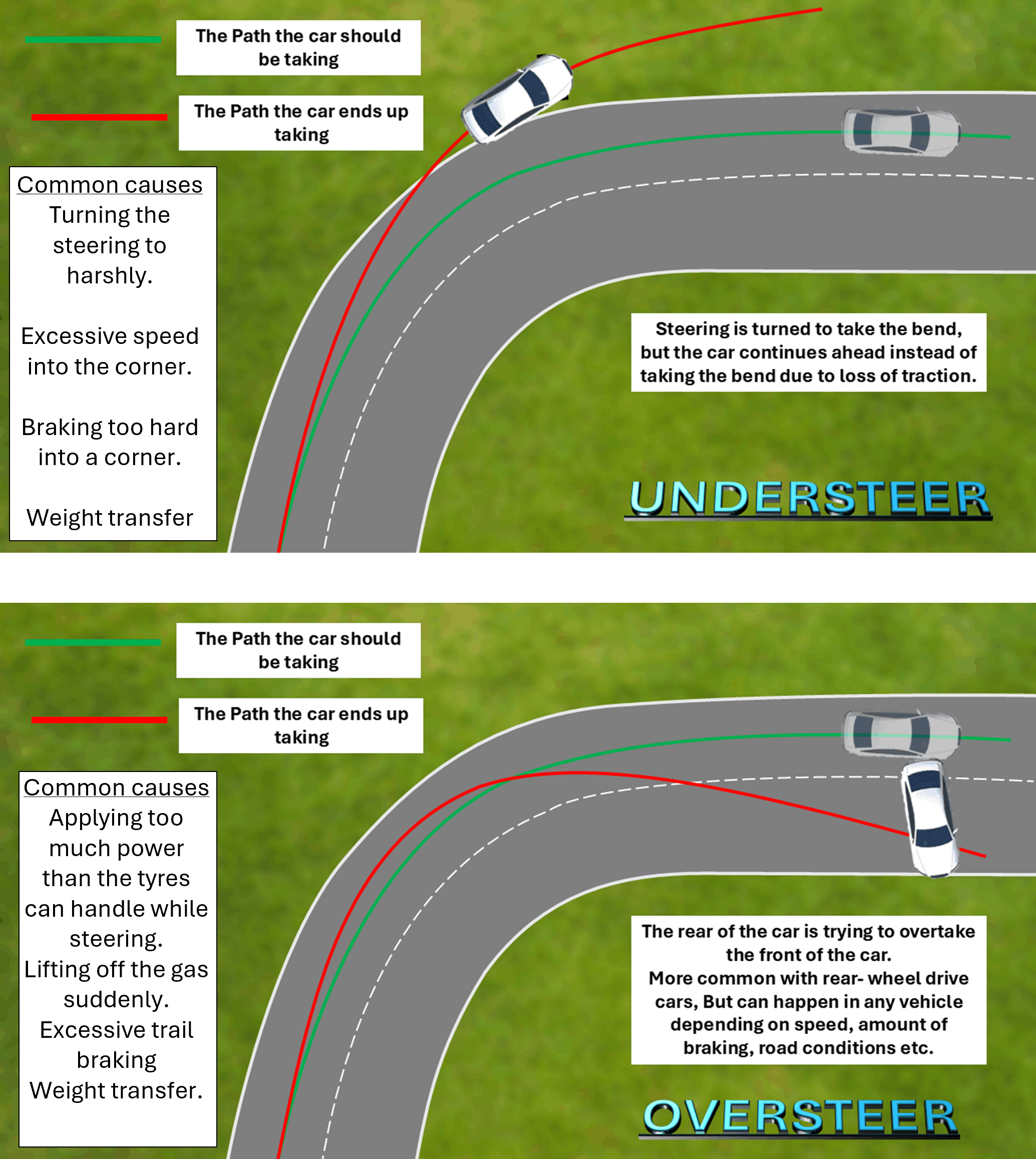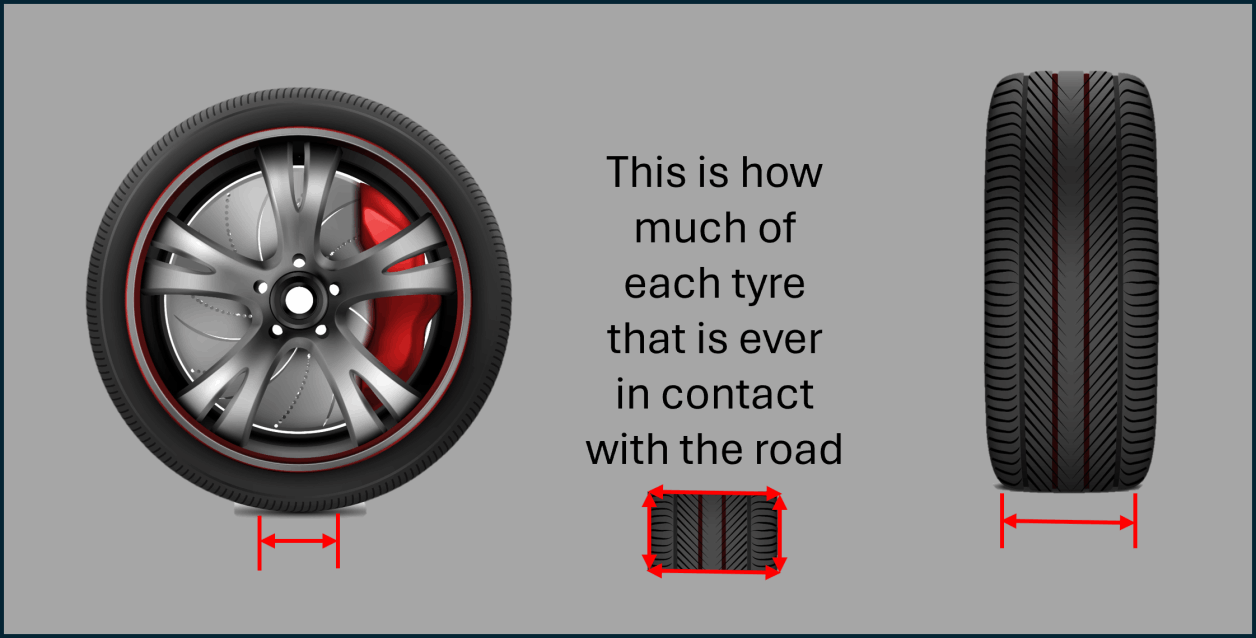
Understanding Oversteer and Understeer will help keep you
ON THE ROAD!

Understanding Oversteer and Understeer will help keep you
ON THE ROAD!

Unless someone has had experience on a skid pan or experience in a large open space, it is highly likely that the vast majority of drivers will not understand fully about Understeer or Oversteer. And experiencing it for the first time on "REAL ROADS" can be extremely scary.
But if driver's drive at the correct speeds for the road they are on and to the weather conditions there is no real reason as to why they should ever experience this in a lifetime of driving.
The two biggest and most common factors involving both of these situations is speed and weight distribution.
What literally happens is weight is distributed causing the car to become unbalanced and a loss of traction to either one side of the car or to the front or rear of the car instead of equal weight distribution around the whole car.
As soon as a car loses traction on any wheel it puts extra pressure on the remaining tyres to keep the car on the road and going in the direction that you want the car to go.
The easiest way to avoid this happening is to PLAN AHEAD, Scan the road for what is coming up, and act accordingly to what you see.
Distracted driving or playing around is when this is most likely to happen.
Not judging the upcoming corner well enough, and not reducing your speed adequately to deal with the bend will invariably end up with a driver hitting the brakes hard to avoid ending up on the wrong side of the road or in a ditch. Drivers will then try to steer more to try and make it around the corner, but with the heavy braking and excessive steering the car will literally become unbalanced , weight will be distributed to just one main wheel and the driver losses control of the car.
Usually these situations are unrecoverable from unless you are prepared for it before it takes place.
Getting some experience to feel how a car reacts in these types of situation can prepare you slightly for an eventuality, but normally a driver will not be prepared for if it happens in real life.
Peer pressure can play a big part in these situations happening by mates egging someone on to go faster.
Unless a driver understands their own capabilities and the capabilities of their car, they won't know what is going to happen until it's too late.
If your mates are egging you on, be the sensible driver and tell them that you want them as ALIVE MATES NOT DEAD ONES!
If you are EVER in a car as a passenger and the driver is making you feel unsafe, don't ask them to slow down, as usually that means
"speed up you're enjoying their ridiculous driving", the best advice we can give is tell the driver you feel sick!
Even go to the extent of mocking that you are reaching.
NO driver will ever want you throwing up in their car!
Once they have stopped, get out, ring a family member or friend who drives safely and get them to pick you up.
Make it categorically clear to the fool who's car you have just got out of, that their driving is unacceptable and that until they change their attitude you will not be being a passenger of their again.
Until people realise that this type of driving is unacceptable, then they will not change their attitude because they think it's clever.
All cars handle slightly differently from each other. Some require a lot of steering to make the car go where you want it to, whereas others may need little steering to achieve the same result. Understanding your vehicle and how much input is necessary is vital for keeping you safe on the road.
Things that may affect how your car reacts are :
Your reaction time.
Your Speed.
Extra Passengers.
Extra weight in the boot.
Items on a roof rack.
Low tyre pressures.
Or over inflated tyres.
The condition of the road will also play a huge factor in whether Oversteer or Understeer take place.
Is the road surface in tip top condition?
Are there loose chippings on the road?
Is there mud or leaves on the road?
Is the road Wet, slippery from snow fall or ice?
Is there a gradient on the road or a camber?
Any vehicle needs to have a good balance to perform well, and if we change how weight is distributed, we also have to change how we drive to suit those changes.
The more weight in a vehicle will affect how its standard set up is designed to keep the car balanced.
Whenever we accelerate, we distribute the weight of the car towards the rear of a car.
Whenever we brake, we distribute the weight of the car to the front wheels.
Whenever we corner, we distribute the weight of the car to the sides of the car.
This creates an UNBALANCED CAR!
So to try and keep the car as well balanced as we can, it is important to have the correct speeds when cornering, speeding up, or slowing down.
Turning into a junction at higher speeds can cause loss of control.
Accelerating to harshly, can cause loss of control.
Braking heavily, can cause loss of control.
Therefore, what ever you are doing on the road, ensure that you do it having planned your course of action first.
Braking heavily on a bend will not only cause a loss of traction to the rear of the car, but also a loss of traction to one or other of the front wheels depending on what direction the bend is.
This literally means you are putting your faith the one wheel is going to keep you one the road.
By reducing your speed first before entering the bend you will have improved your ability to control the car around that bend.

If you actually consider how much of your actual tyre is in contact with the road, and then consider how much faith you are putting in that rubber keeping you in a straight line, you'd probably change your driving style for the better.
On a generic everyday family car, each tyre has about the same amount of rubber in actual contact with the road as the size of an adult palm.
Each time you brake heavily or accelerate heavily you are virtually losing a vast percentage of that traction to either the front, the rear or the front and rear wheels.